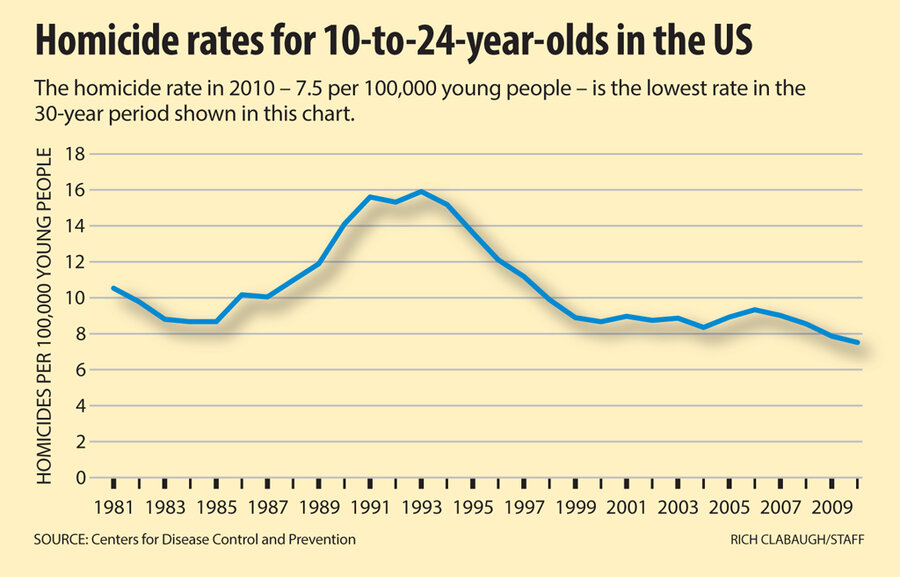Youth homicide rate hits 30-year low, but it's not good news for everyone
Loading...
Youth homicide rates have hit a 30-year low, according to a new report from the Centers for Disease Control and Prevention (CDC) that examined data from 1981 to 2010.
After a sharp increase in the late 1980s and early 1990s – hitting a high in 1993 – the rate has continued to fall.
That's the good news. But homicides, about 80 percent of them due to firearms, are still identified as one of the three leading causes of death for youths aged 10 to 24, the age range used in the study. And since 2000, the decline has slowed considerably, dropping only about 1 percent a year.
There are also still large disparities among different groups, with blacks, males, and youths aged 20 to 24 all much more likely to be homicide victims. And the declines in homicide rates for those at-risk groups have been even slower than for their peers.
"If we really want to reenergize the declines in youth homicide and try to knock it off where it is right now as the third leading cause of death for young people, we need to be more proactive and focus on primary prevention" of violence, says Corinne Ferdon, a behavioral scientist with the CDC's Division of Violence Prevention and an author of the report.
Since 1981, the report shows the homicide rate fluctuating considerably, with the biggest changes in the 1980s and '90s. Between 1985 and 1993, for instance, there was a steep rise of 83 percent, up to 15.9 homicides per 100,000 young people. Then, in the following five years, there was a 43 percent drop.
While the CDC analysis didn't identify reasons behind these trends, Dr. Ferdon says that other research has pointed toward things like the crack cocaine epidemic, drug-related crime, an increase in weapon carrying, and a weak economy as some of the factors in the sharp rise in homicides in the late ’80s and early ’90s. As those factors abated, the homicide rate dropped sharply.
"What gives us a little bit of concern is that that really promising decline that began started to slow down around 2000," Ferdon says. "Between 2000 and 2010, we continued to see a decline, but it was significantly slower – slower than we would like."
In 2010, the most recent year for which the report has statistics, the homicide rate for individuals aged 10 to 24 was 7.5 per 100,000 – the lowest in the 30-year period studied.
But it was much higher for males (12.7 per 100,000), individuals aged 20-24 (13.2 per 100,000), and blacks (28.8 per 100,000).
"What this report helps us see is where we need to focus our efforts," Ferdon says. The prevention strategies with the highest success rates, she says, are those that take a comprehensive approach, since there isn't a single cause in isolation that drives youth violence. School-, family-, and community-based programs that help address broad issues like crime and poverty all help, says Ferdon, who especially lauds "primary prevention" strategies that aim to get youths off a trajectory toward violence at a young age.
"We have to be in part engaging these higher-risk groups, helping them gain access to these primary prevention approaches," says Ferdon.








